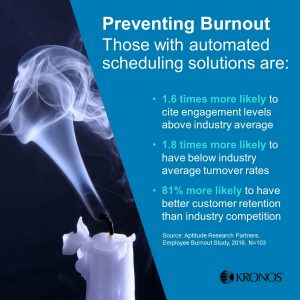(Editor’s Note: Today’s post is brought to you by our friends at Kronos, the global leader in delivering workforce solutions in the cloud. To help employers navigate the upcoming U.S. Department of Labor changes to overtime pay, Kronos has published a research brief on The Changing Face of Wage and Hour Law. You can download it on their website. Enjoy the post!)
When employees are unable to do their work, it’s a concern to business. We need employees performing their best. It drives morale and engagement, which in turn, impact productivity and the bottom-line. However, when we think about employee stress, we have to be careful not to lump all forms of exhaustion into the same category.
For example, let’s take burnout and fatigue. The two words are often used interchangeably but they’re really two different things.
Fatigue is a state of extreme tiredness. It can be very detrimental to employees and the business. It’s usually considered to be a short-term condition and often can be remedied.
Burnout is a physical or mental collapse. It’s very serious, can be considered a long-term condition, and lead to employee disengagement and turnover. It’s also very difficult to reverse.
Today, I want to focus on burnout. Not because fatigue isn’t important. But because some of the things that happen in today’s fast paced, technology driven workplace can lead to burnout. You know, like checking your emails at midnight, not taking vacation, or feeling like you always need to be “on.” Burnout can quickly spread throughout the organization. And if managers get burned out, well, I’ve never seen a burned out manager with a calm team.
Think about the implications of burnout taking hold in the organization. According to research from Aptitude Research Partners, organizations that have above average rates of burnout are 66 percent more likely to lose top performers than their competitors. The research also found that 67 percent of respondents have experienced productivity or quality issues due to employee fatigue or burnout.
However, very few organizations are making employee burnout and the resulting loss of employee engagement a top priority. Less than 50 percent indicate that burnout is a top organizational concern even though research from Gallup shows that organizations with highly-engaged employees are 22 percent more productive. And companies with sustained employee engagement have operating margins 3x higher than companies with low levels of engagement.
The Drivers of Burnout
Now to be fair, maybe one of the reasons that companies aren’t making burnout a priority is because they don’t know how. Burnout is a complex issue. In the white paper “Moving Beyond Burnout,” the top two drivers are:
- Workload – What this refers to is planning and scheduling. When managers create effective, predictable schedules, everyone wins and no one is scrambling around trying to cover the operation.
- Work environment – This is the organizational culture. It’s about communication and setting expectations. Employees need to know how to balance their personal and professional lives so they can take care of themselves.
The good news is that technology can help reduce the negative impact of these drivers and support healthy habits.
4 Technology Solutions to Minimize Burnout
Both employees and organizations have the opportunity to use technology in ways that can minimize the effects of burnout. Since one of the key drivers is workload, giving employees more control over planning and decision making in their work schedule could create greater flexibility and be perceived as a benefit. Two ways to do that include:
Employee self-service provides employees with access to their personal records and payroll details. They are able to request time off, change their contact information, and view other personal details. This is not only helpful to the organization in terms of administration but it allows employees immediate answers to common questions. And for hourly workers, they can enter their availability or shift preferences. Being able to work when you want makes employees happy and can reduce burnout.
Workforce management solutions such as online scheduling and shift swaps give employees flexibility. Pew Research indicates that close to 70 percent of U.S. adults have a smart phone. When considering technology solutions for scheduling, it only makes sense for employees to use the tools they have regular access to. In addition, research from Kronos shows that organizations that provide shift swapping have 55 percent higher engagement and 53 percent less turnover.
Managers have an opportunity as well to deal with the drivers of burnout in real time. They can take proactive steps to reduce burnout by making sure employees have schedules that include adequate rest periods. Managers can use technology in two ways:
Human capital management (HCM) solutions give managers data on proper staffing levels in time to manage overtime and redistribute workloads. While it’s true that organizations may have to scramble occasionally, that should be the exception versus the norm. Organizations providing predictable schedules are 174 percent more likely to have an engaged workforce.
Absence management programs provide managers with the ability to set expectations and monitor resources. Today’s automated absence programs can also infuse a bit of fun using gamification techniques to change employee behaviors. Seventy-eight percent of organizations with a process in place to manage absences have below average turnover.
Bottom-line: The key to limiting the contagious nature of burnout is to give employees control over their work and implement programs that focus on allowing employees to work when they want to work. The more predictability we can have in scheduling, the less last minute scrambling for shift coverage, and fewer employees having to pick up the slack.
[clickToTweet tweet=”The time to think about employee burnout is before it becomes an issue” quote=”The time to think about employee burnout is before it becomes an issue” theme=”style3″]
Human Capital Management Strategies Can Minimize Employee Burnout
The time to think about employee burnout is before it becomes an issue for the organization. Taking proactive measures is the first step. Kronos has a dedicated resource with tools and information about reducing the effects of employee burnout. You can find it at: http://www.kronos.com/burnout. Also, be sure to download the white papers mentioned in this post and take a listen to the archived Kronos webinar “Employee Burnout is a Complex Problem – But it Doesn’t Have to Be.” HCM strategies can positively impact the workplace from both an employee and management perspective.
3









[…] The time to think about employee burnout is before it becomes an issue. Kronos shows us how we can use technology to help minimize employee burnout. […]